2012 MoonBlog
This isn't really about the moon, I call it a moonblog because a new homepage image appears twice a month on the new and full moon. The home page shows a featured image —sometimes freshly minted, sometimes seasonal, sometimes from years past— along with improvised ruminations. Previous years' entries are here for your perusal, something like a leisurely blog. See the links, above.
Grumman Goose
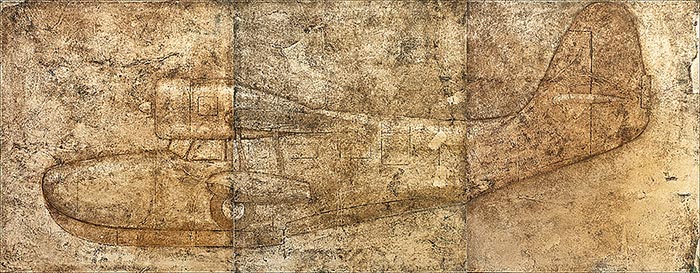
The Grumman Goose seaplane. This painting is a triptych, part of a series that I've been calling Aeroplanes, started last summer for my Sabbatical Exhibition at Naropa University. What is it about style that ages? Leaf through a magazine from ten or twenty years ago and you can feel the passage of time. Some things hold up better than others. (Look back at some high school photos of yourself and your friends: how about that hair?) The mid-twentieth century was, in my opinion, a golden era of style in the United States. Everything from clothing to hairstyles to portraiture, cars, films, architecture, housewares, and music conveys enduring elegance and panache, an unexpected feature of an era of sustained economic depression.
Many of the planes from that era –both civilian and military– while outmoded technologically, still hold their own in the style department. The design of the Grumman Goose resulted from a 1930s commission by some wealthy New York businessmen wanting to commute into the city easily from their Long Island getaways. The plane later proved to be a versatile troop transport plane during the Second World War. A number of Grumman Geese are still in use today; I'm pretty sure I saw one make an appearance in the 1997 David Mamet film The Spanish Prisoner. This painting is acrylic, gesso, cheesecloth, and molding paste on canvas, in three panels 42″ x 108″ overall. Why a Grumman Goose? I don't know...maybe it's a Christmas Goose.
New Moon ~ December 13th, 2012
Beetle Restoration
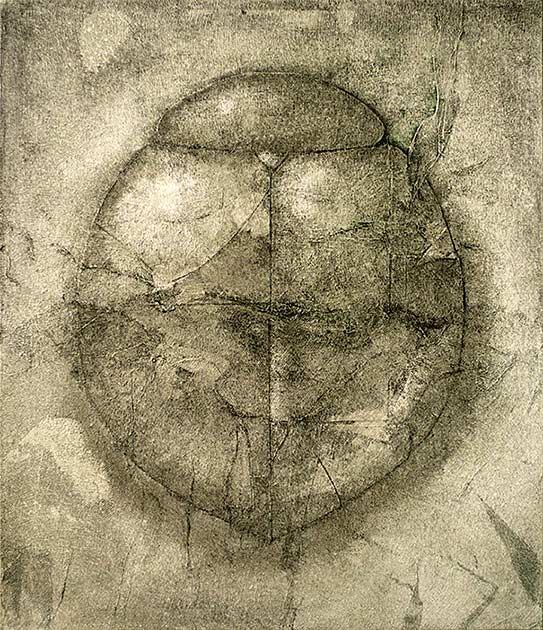
More beetles. I produced a number of beetle paintings for two shows this past summer and fall. I'm now working on a suite of them for display at the Garrison Institute in New York in January. This one here may be in progress, I'm not sure. Surprise seems to be a both exciting and unnerving feature of creative activity: the work at hand starts to become autonomous; it might begin going in its own direction or taking on qualities that are not what you had in mind at the start. It's easy to miss the enjoyment of this if you're stuck on your original idea. I'm calling this one Beetle Restoration for the moment. It reminds me of reconstructed ancient pottery that you see in museums. I've always admired the way archeologists carefully restore broken items after digging them up. Ordinary household objects take on a kind of renascent beauty. These new beetle paintings are similar to work I was doing earlier this year: deeply textured with canvas scraps, cheesecloth, and godknowswhatelse. They are all 28″ x 32″
Full Moon ~ November 28th, 2012
Greenhorn Mountain, Colorado
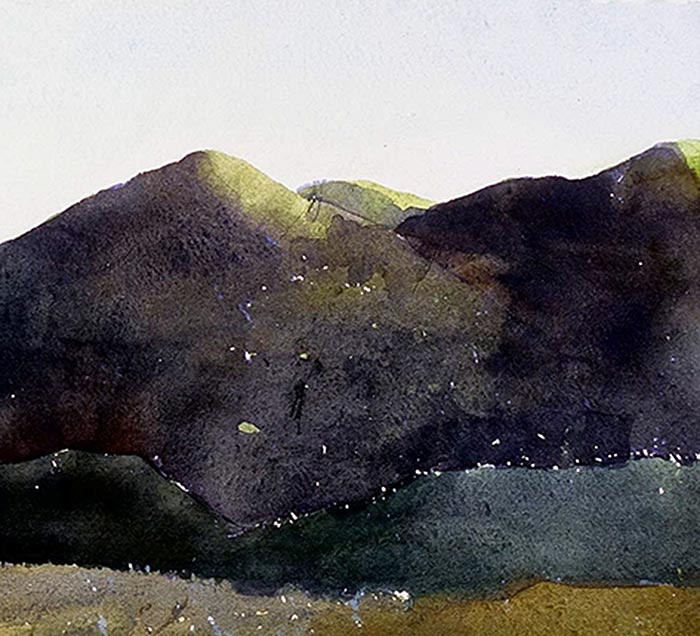
I've spent a lot of time in the vicinity of Greenhorn Mountain in southern Colorado's Huerfano County. This mountain is named after the Comanche chief Tabivo Naritgant, whom the Spanish called Cuerno Verde. Cuerno Verde means “Green Horn”; he was so named because of his unusual headdress adorned with green-tinted horns. Tabivo Naritgant was killed in a battle with a Spanish force led by Juan Bautista de Anza in the fall of 1779. The mountain after whom he is named is said by some to be one of the oldest mountains in North America. Although it is plainly visible from Interstate 25, there is nothing spectacular or “recreational” in the vicinity of this massive, ancient mountain; this has protected it from hoards hungry for spectacle. I think of Greenhorn Mountain as being a hidden beauty: she knows too well the dangers of flaunting attractions carelessly, and has been stung before by resource “development”. Even as I write this, her shoulders are being pierced by Shell Oil, keen to capitalize on humanity's insatiable thirst for easy energy. We're praying they don't find any here. Oh, the painting: it's a watercolor, 9 by 10 inches. It's whereabouts are unknown, having long since disappeared into the vastness of life.
New Moon ~ November 13th, 2012
Hurricane Sandy

This painting is part of a series done a few years ago, which I call The Atlantic Folios. I'm putting it up on this full moon because, even though I'm over a thousand miles away from the Atlantic, it's on my mind: As I'm writing this an enormous storm is making landfall on the eastern United States. A category 1 hurricane is merging with a winter storm moving across the continental U.S. These two will be joined by an Artic front rolling in from Canada. Meteorologists are calling it a “Frankenstorm”.
There is also bearing down on the country a closely contested presidential election, for which early voting has already begun. Powerful forces that don't mean well have steered much of the electoral process, marshalling the fears, uncertainty, and impatience of a tired and tragically divided electorate. It feels that the American experiment itself is imperiled, awash in money with a dangerously incurious populace easily swayed by bald deception. By the next new moon we'll know the outcome. Meanwhile, there is this unnerving rendevous of the existential and the meteorological.
Full Moon ~ October 29th, 2012
Dry Creek
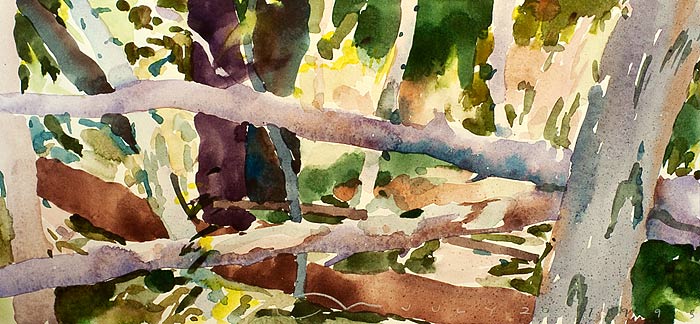
This is a watercolor of Dry Creek in southern Colorado. There are probably hundreds of seasonal creeks all over the American southwest named “dry creek”; these creeks run vigorously during the spring snow melt. Some time in late June the water peters out and that's about it for the year. This particular Dry Creek runs through the Libre commune in Huerfano County, Colorado. It's hard for me to believe that I did this painting seventeen years ago — it seems as though it was just last summer. This painting arose during a session of finding an infinite number of possible compositions in the chaotic tangle of a forest left alone. In fact, you could find a thousand compositions within ten feet of where you are sitting right now. I've been reading Where the Heart Beats, Kay Larson's book about the twentieth century composer John Cage. The author traces the development of Cage's thinking and his discovery of what he called “chance operations”, entering the continuous stream of vivid phenomena; letting things speak for themselves, unburdened by artistic manipulation. This painting isn't a chance operation but it takes its fresh energy from the artless tumult of untended wilderness.
New Moon ~ October 15th, 2012
P-51 Mustang
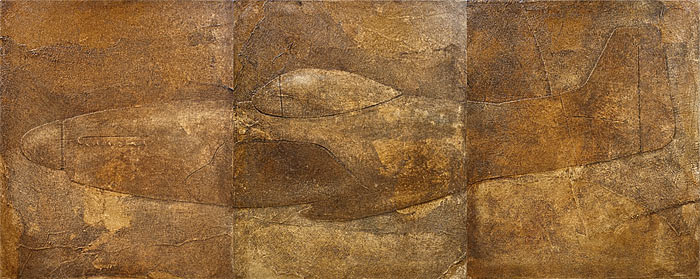
Here is a three panel painting of a P-51 Mustang fighter plane, one of the most successfully designed planes of the Second World War, especially following the collaboration between American and British manufacturing. This painting is another of the four fighters currently on view at my Sabbatical Exhibition at Naropa University. The painting is a highly textured triptych measuring 26″ x 66″, acrylic on canvas with various fabrics and inclusions.
This show will up for a few more weeks – until October 19th at Naropa University's Nalanda campus, 63rd and Arapahoe Avenue in Boulder, Colorado. If you are in the area, go have a look. If you're too far away or if the closing date has come and gone, you can view the images online here.
Full Moon ~ September 29th, 2012
Ashy Gray Lady Beetle
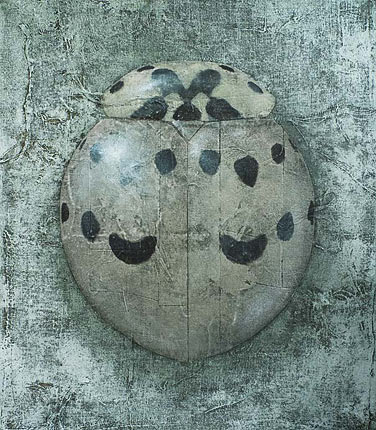
This is a painting of an Olla abdominalis, also known as an Ashy Gray Lady beetle. I spent much of this past summer avidly painting in preparation for two shows. I was also wrinkling my nose at the rapidly waning days of my year's sabbatical from Naropa University. This painting was the most recent of the series and became the image I used to advertise my sabbatical exhibition at Naropa. For this and other recent paintings I took a lot of pleasure in using up old canvases and scraps of burlap, cheesecloth, and other materials. This painting is 42″ x 48″ and in the Naropa exhibition occupies a prime spot at the end of a very long hallway. This show will up for several more weeks – until October 19th. It's at Naropa University's Nalanda campus, 63rd and Arapahoe Avenue. If you are in the area, go have a look.
New Moon ~ September 15th, 2012
Cryptocephalus Vittatus
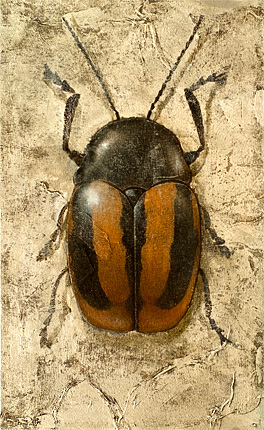
This is, of course, a painting of a Cryptocephalus vittatus beetle. This past summer I did a lot of paintings of insects, especially beetles. I'm not sure which aspect of them interested me the most. Sometimes it was the color schemes, sometimes the shape of the whole body. The visual look of the work itself is also an obvious homage to old botanical and zoological illustrations, of which I am a big admirer. I suppose these could continue in the direction of mimicking that look, or they might morph into something else. In more recent work in this mode I've been experimenting with leaving out the legs altogether. Then they start looking like something other than just insects – vessels, shields, jewelry. In the process of researching these, I discovered a marvelous website put up by a Russian insect photographer named Boris Loboda. Go and have a look, I'll wait for you.
Full Moon ~ August 31, 2012
Douglas Dauntless
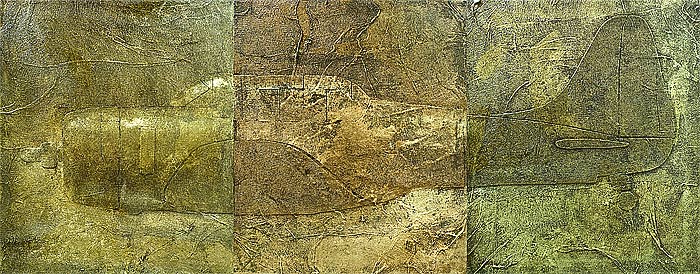
Here's a painting of a Douglas Dauntless, a World War II dive bomber. The painting is a three panel piece, 26″ x 66″ overall, acrylic on canvas with a lot of surface additions, including canvas shapes cut out in the outline of the plane, along with several layers of cheesecloth and gesso. It's part of a set of four paintings of fighter planes from the Second World War. I expect you'll see more of these here as the weeks go by. This painting and its companions will be on display in a large solo show at Naropa University, which will be hung in a few days. There are two images of World War II planes that occur earlier here (scroll down a bit), the Grumman Hellcat and the P-47 Thunderbolt. Since those earlier paintings, the surface has become more crude, almost archeological. One never knows if this is evolution or regression, but the newer surfaces convey an uneasiness about what is what. They are less defined by line, with details sometimes obscured by chance surface activity, giving them a quality reminiscent of the hauntingly preserved Iron Age bog bodies found in sphagnum peat bogs all across northern Europe.
New Moon ~ August 17, 2012
Coleoptera

This painting is part of a group of four Coleoptera – and the beginning of a new series. Coleoptera is the name of the order of insects comprising beetles and weevils. It's the largest order of animals on earth. I'm interested in them because their designs and color schemes are so frequently fetching. This one is fresh this week and probably in progress. It's 32″ x 40″; so that would be a large beetle in person. The material is acrylic on canvas with textures added using multiple layers of gesso, molding paste, and other secret ingredients. It's likely that I'll change the background color to something closer to parchment or vellum. Lately I've taken pleasure in painting over canvases that haven't passed the test of time, meaning that they were experiments that look a bit silly after a few years. Some artists go through occasional fits of destruction, obliterating years of previous work. My approach is more penurious: why waste a good canvas?
Full Moon ~ August 1, 2012
Une Jeune Femme
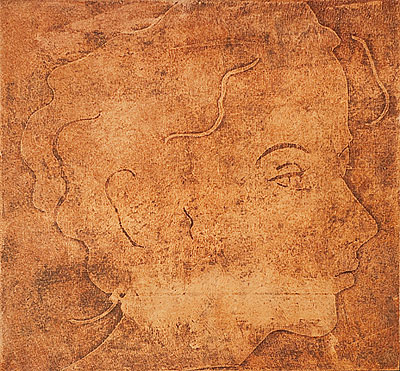
The painting here is based loosely on a three-minute ink line portrait of one of my students. I frequently experiment with ways of painting that approximate the feeling of old, stained drawings. In the method here, which also has the look of embossing, I'm cutting scraps of canvas to the shapes in the drawing and attaching them to the canvas. Then I add a layer of cheesecloth on top of that, then some random “patching” with modelling paste. When everything is dry I add the color and do a lot of experimental wiping away, sometimes repeating the process or re-layering it with more gesso. The textural roughness gives a feeling of something like mummification. (Wrong word? Sorry!) This is the same method used below in the Grumman Hellcat image for the last full moon. I'm working on some much larger pieces that in the end should look like faux Assyrian wall reliefs. I did this painting over the past several days as an experiment while I explore the technique. It's 24″ x 26″, acrylic on canvas.
New Moon ~ July 18, 2012
Grumman Hellcat
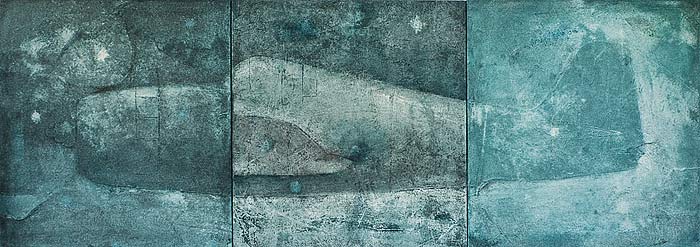
This three panel painting (26″ x 72″) is part of a new series of World War II fighter planes. This one is of a Grumman F6F Hellcat, a carrier-based fighter plane equipped with folding wings and Pratt & Whitney R-2800-10W “Double Wasp” two-row radial engine with a two-speed, two-stage supercharger at 2,000 hp, yielding a maximum speed of 380 m.p.h. The plane turned out to me a worthy match for the deadly Japanese Zero. The paintings I'm working on here seem to be pulling at images from a childhood where these planes were the stuff of legend: The USA had come to the rescue of its allies to push back the threat of world fascism. And with death and destruction unprecedented in human history, the allies prevailed. At least for a while. The paintings in this series make use of a surface of layers of canvas and veils of open-mesh cheesecloth, sealed with several layers of gesso and modeling paste. The effect is strangely haunting, somewhere between a faded tapestry and old tattered photos left by the dead.
Full Moon ~ July 3rd, 2012
Villard's Rabbit
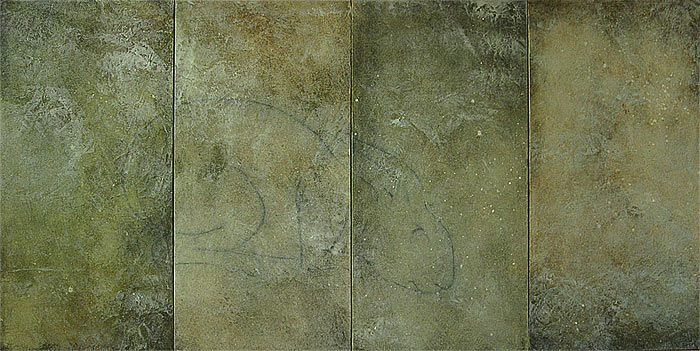
I call this Villard's Rabbit because it is copied from a famous sketchbook of Villard de Honnecourt, an enigmatic medieval artist about whom very little is known with certainty. The only evidence of his life is a book of drawings on vellum, which resides at the Bibliothèque Nationale de France in Paris.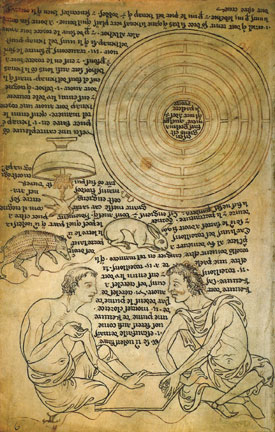 Honnecourt's original rabbit drawing is quite small, not quite two inches across. You can see it here on the right in its original setting on the page; it's just below center. I've used it here as the single image on a four panel screen, which makes the image quite a bit larger. The whole screen measures 40″ x 80″. It's a work in progress and may undergo substantial changes before it's either finished or ruined. I've lately been making paintings from the sketchbooks of other artists, as if to amplify or bring to completion someone else's visual idea. It's really enjoyable and opens up an infinite vein of material. Is it stealing? Naaah. There is a beautiful book by Dr. Carl F. Barnes, Jr., which has complete, full color images of Honnecourt's original manuscript along with meticulously researched commentary. You can find out more here: Honnecourt Book.
Honnecourt's original rabbit drawing is quite small, not quite two inches across. You can see it here on the right in its original setting on the page; it's just below center. I've used it here as the single image on a four panel screen, which makes the image quite a bit larger. The whole screen measures 40″ x 80″. It's a work in progress and may undergo substantial changes before it's either finished or ruined. I've lately been making paintings from the sketchbooks of other artists, as if to amplify or bring to completion someone else's visual idea. It's really enjoyable and opens up an infinite vein of material. Is it stealing? Naaah. There is a beautiful book by Dr. Carl F. Barnes, Jr., which has complete, full color images of Honnecourt's original manuscript along with meticulously researched commentary. You can find out more here: Honnecourt Book.
New Moon ~ June 19th, 2012
P-47 Thunderbolt
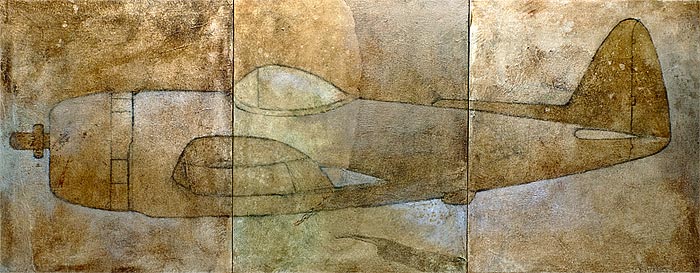
The P-47 Thunderbolt was one of the most widely used Allied fighter planes during the Second World War. It underwent numerous design changes over the course of the war, the version here with the bubble cockpit being one of the last. It may or may not be a coincidence that I started work on a series of American fighter planes on Memorial Day a few weeks ago: I was born four years after the end of World War II, when it was still fresh in the collective memory. The details of that war –especially as it erupted across Europe– have haunted my imagination all my life. Many of the fighter planes used on all sides were ingenious, deadly, and to my eye, strangely beautiful. Most of them are gone now, as are the daring pilots who flew them, and the paintings I'm working on have the quality of wraiths. This painting is a triptych with overall dimensions of 26″ x 66″. It's a work in progress — one of a quartet of American fighter planes from that conflict.
Full Moon ~ June 4, 2012
Near Eldorado
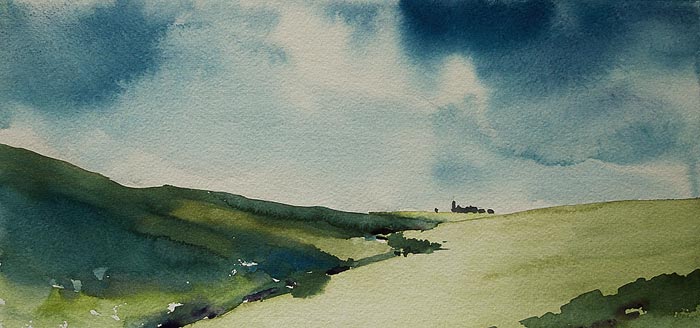
This is a watercolor done in the field near Eldorado Springs, Colorado. I did this about twelve years ago while leading an outdoor painting class called Evening Light. I would take a group of fifteen people to various locations around Boulder, Colorado where I live. This we did five days in a row from five until eight P.M. in the early summer. Painting and drawing things intensifies seeing and to be out in that slant of light at that time of day – even when the painting went badly – was surprisingly pleasurable. The class ran for several summers and then we ran afoul of the Boulder Parks department. Well, we were supposed to be keeping on the trails and we didn't. It was really blissful while it lasted; I recommend going out, at least for a walk, during the final two hours of the day before the sun goes down. The painting here is 6 x 10 inches.
New Moon + annular eclipse ~ May 20, 2012
Heralds' Feet

The painting here is something I'm working on right now. It's acrylic on canvas on four panels. The overall size is 42″ x 108″, so it's fairly large. It may be close to done or it may undergo major changes before it's either finished or ruined.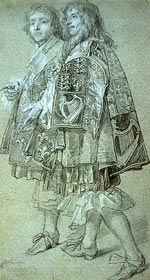 In any case, the stage that it occupies right now has its own mystery and elegance, which I'm inclined to leave as is – at least for the moment. In preparation for a show coming up at Naropa University this fall, I'm working on some large paintings based on old drawings, other peoples' drawings, so-called “old master” drawings. This painting is from a detail of a drawing of two heralds by the seventeenth century Dutch painter Pieter van der Faes; later, in England, he became Sir Peter Lely (1618–1680); the drawing, shown at right, lives at the famous Albertina Museum in Vienna. Seeing my painting and the drawing on which it is based will fairly make you wonder what I'm thinking. I'm not trying to convey any specific meaning with this; I simply liked the legs and shoes in the drawing. With this series I'm experimenting with the visual impact of old drawings that have spent some time in the world; many of them have stains and rips and stamps as evidence of a working life.
In any case, the stage that it occupies right now has its own mystery and elegance, which I'm inclined to leave as is – at least for the moment. In preparation for a show coming up at Naropa University this fall, I'm working on some large paintings based on old drawings, other peoples' drawings, so-called “old master” drawings. This painting is from a detail of a drawing of two heralds by the seventeenth century Dutch painter Pieter van der Faes; later, in England, he became Sir Peter Lely (1618–1680); the drawing, shown at right, lives at the famous Albertina Museum in Vienna. Seeing my painting and the drawing on which it is based will fairly make you wonder what I'm thinking. I'm not trying to convey any specific meaning with this; I simply liked the legs and shoes in the drawing. With this series I'm experimenting with the visual impact of old drawings that have spent some time in the world; many of them have stains and rips and stamps as evidence of a working life.
Full Moon ~ May 5, 2012
Kerry from Valentia Island
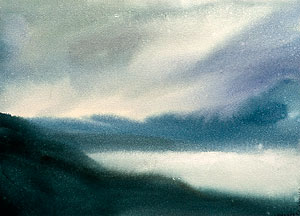
This watercolor, along with three others, is on its way to Ireland for a sale to benefit the Cill Rialaig artists' retreat in County Kerry. I had the good fortune of spending two retreats there, one in 2003 and another in 2007. Cill Rialaig's founder and patron saint, Noelle Campbell-Sharpe, has insisted that visiting artists should be able to come to Cill Rialaig free of charge. Funding this has been a challenge in recent years with the continuing slump in the global economy. You can get more info about this benefit sale at the Origins Gallery in Dublin. May the sale go well. The painting here is based on a view from Mossie and Mary O'Sullivan's cottage on Valentia Island. My grandmother, her parents and siblings left Valentia for America in the 1880s. It must have been a sad time for those who remained: during those same years tens of thousands of Irish left every month, most of them never returned. It was haunting for me to go back to Valentia knowing that some of my distant ancestors were buried there in unmarked grave plots in the disintegrating Kylemore burial ground. I was able to find important clues about my grandmother and I did get water from one of the springs there, which I hope to pour onto my grandmother's grave in New London, Connecticut; she died there in the 1918 flu epidemic a week after my grandfather. They were both in their mid thirties.
New Moon ~ April 21, 2012
Huerfano Iris
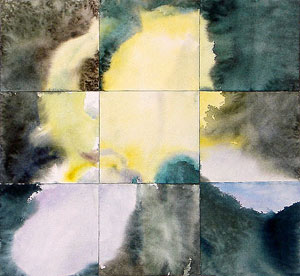
Some time shortly after the turn of the century I re-discovered iris. We found a bed of them abandoned in a closed-down trailer court in Boulder, Colorado. They had made a life for themselves unattended for several years. Iris are tough. This is a good thing because I'm an irresponsible gardener; you might even say I'm an abusive gardener. Anyway, iris are beautiful and their variety is endless. The yellow iris here was recovered from a long abandoned homestead in Huerfano county in southern Colorado. The painting here is another example of my perennial affection for grids. This series was done in a peculiar manner: each square is a watercolor done in isolation from its neighbors, then assembled into a whole. Somehow this approach encouraged relaxation and looseness. I did this one about ten years ago. The piece is about 18″ x 18″.
Full Moon ~ April 6, 2012
Marissa's Hands
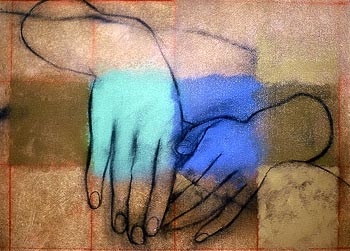
This painting came out of a series of one hundred drawings of hands that I did about ten years ago. Come to think of it, it may have been closer to fifteen years ago. Either way, the idea of doing one hundred pieces on a theme is an old idea and one I recommend in any medium: drawing, painting, music, poetry, risotto, or whatever you like. The eighteenth century Japanese artist Katsushika Hokusai did at least two series called, One Hundred Views of Mount Fuji, reproductions of which are still in wide circulation today. The contemporary artist Alfred Leslie has his One Hundred Views Along the Road; Jennifer Bartlett's In The Garden is another fine example —in in this series, she did over two hundred images of the same fountain in an exuberant display of technical experimentation. The painting here is acrylic and charcoal on canvas; the image is 22″ by 30″. And who is Marissa? Marissa Tiroly, a former student, marvelous artist and performer, and old friend. I always admired her hands.
Full Moon ~ March 9, 2012
Cowries
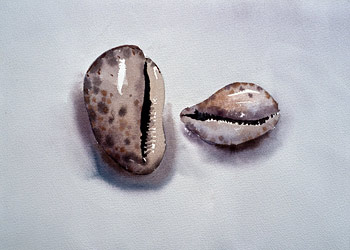
Cowrie shells have a long and colorful relationship with humans. In some parts of the world they are symbols of wealth and have even been used as money. Their visual appearance also have associations with fertility and birth. Some of my colleagues in the art therapy program at Naropa University have been organizing an ongoing service to Cambodian girls and young women who have been cruelly harmed by the sex trade prevalent in that part of the world. To raise money for their efforts on the victims' behalf they are hosting a grand fundraising art auction event on March 17th in Boulder, Colorado. I did this painting and other watercolor paintings of cowrie shells which will be on auction along with a series of matchbox creations made especially for the event by an array of artists. I chose the cowrie as a symbol of healing for this endeavor because of its feminine symbolism and its cool distance from human brutality. Read more about the art event for Cambodians here and here.
New Moon ~ February 21, 2012
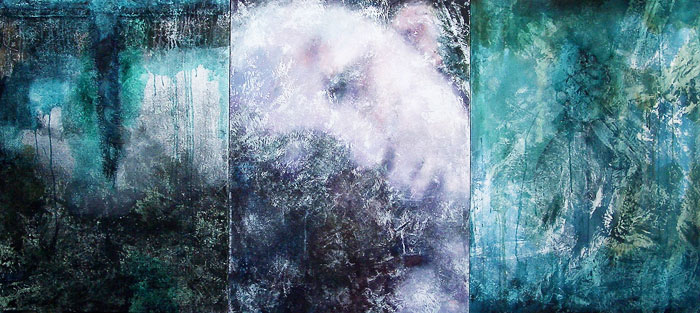
This is another one of the combo paintings from about ten years ago. I guess when I was experimenting this way I didn't quite believe in the paintings' final results. I wish I had. When I look at paintings like this now I find their queasy uncertainty is more to my liking. It is one of the maddening things of artistic practice to not know what you are doing. It's easy enough to come up with a scheme and easy enough to draw conclusions about what has been done, but clarity in the moment of doing is elusive. This, by the way, is why mindfulness practice holds my interest: it turns out to be quite difficult to steady the mind; it's always on its way elsewhere. I suspect that this flitting quality of the mind is why artistic practice is both useful and surprisingly demanding. The painting here now makes more sense to me. The puzzlement of doing of it now makes sense to me. Unfortunately, the three panels of this painting have gone their separate ways and the triptych no longer exists.
Full Moon ~ February 7, 2012
Pitcher and Lake
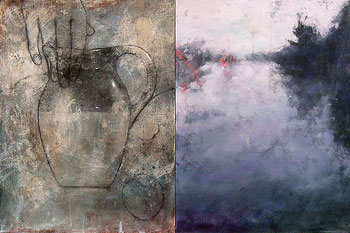 During the late 1990s and early 2000s I found myself combining paintings that may have been done at different times, sometimes with very different intentions in mind. The resulting diptychs and triptychs make for an odd viewing experience: What are these two doing together? Apart from combining images that were neatly the same size, the process was not logical. There was a lot of trial and error, of the sort that cooks are familiar with; it's a matter of tasting as you go. I still like to work with images when I'm painting. Literal references are loaded with flexible associations of all kinds, triggering responses that depend on the circumstances. The two images here - one of a flea market pitcher and hand, the other of what appears to be a lake (it is actually based on a photo taken of a highway during a thunderstorm deluge) are joined in a kind of matrimony, just like most couples we all know. You sometimes wonder what the initial attraction was but here they are years later having settled together into crusty elegance.
During the late 1990s and early 2000s I found myself combining paintings that may have been done at different times, sometimes with very different intentions in mind. The resulting diptychs and triptychs make for an odd viewing experience: What are these two doing together? Apart from combining images that were neatly the same size, the process was not logical. There was a lot of trial and error, of the sort that cooks are familiar with; it's a matter of tasting as you go. I still like to work with images when I'm painting. Literal references are loaded with flexible associations of all kinds, triggering responses that depend on the circumstances. The two images here - one of a flea market pitcher and hand, the other of what appears to be a lake (it is actually based on a photo taken of a highway during a thunderstorm deluge) are joined in a kind of matrimony, just like most couples we all know. You sometimes wonder what the initial attraction was but here they are years later having settled together into crusty elegance.
New Moon ~ January 23, 2012
Bosc Pears

This painting, which I did some time in the mid 1990s, was the first home page image on my first web site, launched ten years ago. I still enjoy the way these pears look: sort of like oiled muscle men on parade. This painting appeared above a quote from Francis Bacon, the English thinker active in the late sixteenth, early seventeenth centuries. He said, “The contemplation of things as they are, without error or confusion, without substitution or imposture, is in itself a nobler thing than a whole harvest of invention.” This is a good description of what meditators sometimes call “non-fabrication”, seeing things without opinion or subjective conceptual overlay.
There was an ancient wild bosc pear tree in my childhood neighborhood of Shrewsbury, Massachusetts. We used to eat the pears by the dozen, young unsupervised hunter gatherers. We also found that the pears could be used as crude writing instruments on the pavement for our early experiments with obscenity. It's likely to have been the start of an artistic lifetime.
Full Moon ~ January 9, 2012
Solstice, Ireland
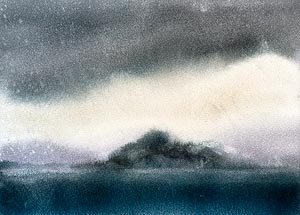 The winter solstice just passed a few days ago. I'm always relieved to know that the sun will be around a little longer now each day. Hibernation makes eminent sense this time of year. Hibernia was a name given to Ireland by the Romans; no one seems sure whether this wasn't their assumption that it was perpetually wintery there or if it was just a linguistic warping of earlier names for Ireland. In any case I'm writing this in dry sunny Colorado, far from Ireland but still feeling the pull. I'm hoping that the turn of the planet will throw new seeds and birdsong from my fingers. It's been a low ebb. Oh, and the painting: this is a watercolor done about a year ago based on two weeks of daily conjurings of Ireland; it's watercolor on paper 10″ x 14″.
The winter solstice just passed a few days ago. I'm always relieved to know that the sun will be around a little longer now each day. Hibernation makes eminent sense this time of year. Hibernia was a name given to Ireland by the Romans; no one seems sure whether this wasn't their assumption that it was perpetually wintery there or if it was just a linguistic warping of earlier names for Ireland. In any case I'm writing this in dry sunny Colorado, far from Ireland but still feeling the pull. I'm hoping that the turn of the planet will throw new seeds and birdsong from my fingers. It's been a low ebb. Oh, and the painting: this is a watercolor done about a year ago based on two weeks of daily conjurings of Ireland; it's watercolor on paper 10″ x 14″.
New Moon ~ December 24, 2011













 Honnecourt's original rabbit drawing is quite small, not quite two inches across. You can see it here on the right in its original setting on the page; it's just below center. I've used it here as the single image on a four panel screen, which makes the image quite a bit larger. The whole screen measures 40″ x 80″. It's a work in progress and may undergo substantial changes before it's either finished or ruined. I've lately been making paintings from the sketchbooks of other artists, as if to amplify or bring to completion someone else's visual idea. It's really enjoyable and opens up an infinite vein of material. Is it stealing? Naaah. There is a beautiful book by Dr. Carl F. Barnes, Jr., which has complete, full color images of Honnecourt's original manuscript along with meticulously researched commentary. You can find out more here:
Honnecourt's original rabbit drawing is quite small, not quite two inches across. You can see it here on the right in its original setting on the page; it's just below center. I've used it here as the single image on a four panel screen, which makes the image quite a bit larger. The whole screen measures 40″ x 80″. It's a work in progress and may undergo substantial changes before it's either finished or ruined. I've lately been making paintings from the sketchbooks of other artists, as if to amplify or bring to completion someone else's visual idea. It's really enjoyable and opens up an infinite vein of material. Is it stealing? Naaah. There is a beautiful book by Dr. Carl F. Barnes, Jr., which has complete, full color images of Honnecourt's original manuscript along with meticulously researched commentary. You can find out more here: 


 In any case, the stage that it occupies right now has its own mystery and elegance, which I'm inclined to leave as is – at least for the moment. In preparation for a show coming up at Naropa University this fall, I'm working on some large paintings based on old drawings, other peoples' drawings, so-called “old master” drawings. This painting is from a detail of a drawing of two heralds by the seventeenth century Dutch painter Pieter van der Faes; later, in England, he became Sir Peter Lely (1618–1680); the drawing, shown at right, lives at the famous Albertina Museum in Vienna. Seeing my painting and the drawing on which it is based will fairly make you wonder what I'm thinking. I'm not trying to convey any specific meaning with this; I simply liked the legs and shoes in the drawing. With this series I'm experimenting with the visual impact of old drawings that have spent some time in the world; many of them have stains and rips and stamps as evidence of a working life.
In any case, the stage that it occupies right now has its own mystery and elegance, which I'm inclined to leave as is – at least for the moment. In preparation for a show coming up at Naropa University this fall, I'm working on some large paintings based on old drawings, other peoples' drawings, so-called “old master” drawings. This painting is from a detail of a drawing of two heralds by the seventeenth century Dutch painter Pieter van der Faes; later, in England, he became Sir Peter Lely (1618–1680); the drawing, shown at right, lives at the famous Albertina Museum in Vienna. Seeing my painting and the drawing on which it is based will fairly make you wonder what I'm thinking. I'm not trying to convey any specific meaning with this; I simply liked the legs and shoes in the drawing. With this series I'm experimenting with the visual impact of old drawings that have spent some time in the world; many of them have stains and rips and stamps as evidence of a working life.




 During the late 1990s and early 2000s I found myself combining paintings that may have been done at different times, sometimes with very different intentions in mind. The resulting diptychs and triptychs make for an odd viewing experience: What are these two doing together? Apart from combining images that were neatly the same size, the process was not logical. There was a lot of trial and error, of the sort that cooks are familiar with; it's a matter of tasting as you go. I still like to work with images when I'm painting. Literal references are loaded with flexible associations of all kinds, triggering responses that depend on the circumstances. The two images here - one of a flea market pitcher and hand, the other of what appears to be a lake (it is actually based on a photo taken of a highway during a thunderstorm deluge) are joined in a kind of matrimony, just like most couples we all know. You sometimes wonder what the initial attraction was but here they are years later having settled together into crusty elegance.
During the late 1990s and early 2000s I found myself combining paintings that may have been done at different times, sometimes with very different intentions in mind. The resulting diptychs and triptychs make for an odd viewing experience: What are these two doing together? Apart from combining images that were neatly the same size, the process was not logical. There was a lot of trial and error, of the sort that cooks are familiar with; it's a matter of tasting as you go. I still like to work with images when I'm painting. Literal references are loaded with flexible associations of all kinds, triggering responses that depend on the circumstances. The two images here - one of a flea market pitcher and hand, the other of what appears to be a lake (it is actually based on a photo taken of a highway during a thunderstorm deluge) are joined in a kind of matrimony, just like most couples we all know. You sometimes wonder what the initial attraction was but here they are years later having settled together into crusty elegance.
 The winter solstice just passed a few days ago. I'm always relieved to know that the sun will be around a little longer now each day. Hibernation makes eminent sense this time of year. Hibernia was a name given to Ireland by the Romans; no one seems sure whether this wasn't their assumption that it was perpetually wintery there or if it was just a linguistic warping of earlier names for Ireland. In any case I'm writing this in dry sunny Colorado, far from Ireland but still feeling the pull. I'm hoping that the turn of the planet will throw new seeds and birdsong from my fingers. It's been a low ebb. Oh, and the painting: this is a watercolor done about a year ago based on two weeks of daily conjurings of Ireland; it's watercolor on paper 10″ x 14″.
The winter solstice just passed a few days ago. I'm always relieved to know that the sun will be around a little longer now each day. Hibernation makes eminent sense this time of year. Hibernia was a name given to Ireland by the Romans; no one seems sure whether this wasn't their assumption that it was perpetually wintery there or if it was just a linguistic warping of earlier names for Ireland. In any case I'm writing this in dry sunny Colorado, far from Ireland but still feeling the pull. I'm hoping that the turn of the planet will throw new seeds and birdsong from my fingers. It's been a low ebb. Oh, and the painting: this is a watercolor done about a year ago based on two weeks of daily conjurings of Ireland; it's watercolor on paper 10″ x 14″.